
Pediatrics Fifth Stage – G:E Infectious Mononucleosis.
1
Infectious Mononucleosis.
• Infectious Mononucleosis (IM; also known as EBV infectious
mononucleosis or glandular fever and sometimes as the kissing
disease from its oral transmission or simply as mono in
and as glandular fever in other English-speaking countries)
is an infectious, widespread
caused by the
Infectious Mononucleosis: Cause
• EBV 90% of acute IM
• Etiology of most EBV-negative IM: unknown
• Other Herpesviruses:
– Cytomegalovirus (CMV)
– herpes simplex 1 and simplex 2
– human herpesvirus 6
• Other viruses:
– adenovirus
– hepatitis A, hepatitis B, or hepatitis C
– rubella
– primary human immunodeficiency virus in adolescents or young
adults
.
VIROLOGY.
• Epstein Barr Virus (EBV)
– Herpes Family – (linear DNA virus HHV4)
– Surrounded by nucleocapsid and glycoprotein envelope
• Also associated with nasopharyngeal carcinoma, Burkitts lymphoma,
Hodgkins Disease, B cell lymphoma.
Epidemiology: Incidence
• Population-based studies; 90% of population have been infected or
have antibodies to the virus.
• Highest incidence rates: 15-19 years.
• No seasonal predilection.
• Higher rate in persons of white race than in other ethnic groups.

Pediatrics Fifth Stage – G:E Infectious Mononucleosis.
2
Primary EBV infection: Seroprevalence
• In developing countries -80-100% of children becoming infected by 3-
6 yrs. of age
– clinically silent or mild disease.
• In developed countries
– occurs later in life, 10-30 years of age
– induce clinically mononucleosis syndrome
Epidemiology: Transmission
• Incubation period: 30 – 50 days.
(shorter in young children)
• Oral secretion
– major role but occur slowly
• Blood products, Transplanted organs
– less commonly than CMV
• Intrauterine
– infrequently
– if infected; no adverse fetal outcomes and no viral transmission
to the fetus.
Pathophysiology
• Reservoir of EBV: Humans only.
• EBV founds in the saliva for the first 12-18 months after acquisition.
• Viral replication
– Lympho-reticular system
– liver
– spleen
– B lymphocytes in peripheral blood.
• Host immune response to the viral infection
– atypical lymphocytes.
• After acute EBV infection, latently infected lymphocytes and epithelial
cells persist and are immortalized
.
• During latent infection, the virus is present in the lymphocytes and
oropharyngeal epithelial cells as episomes in the nucleus
.
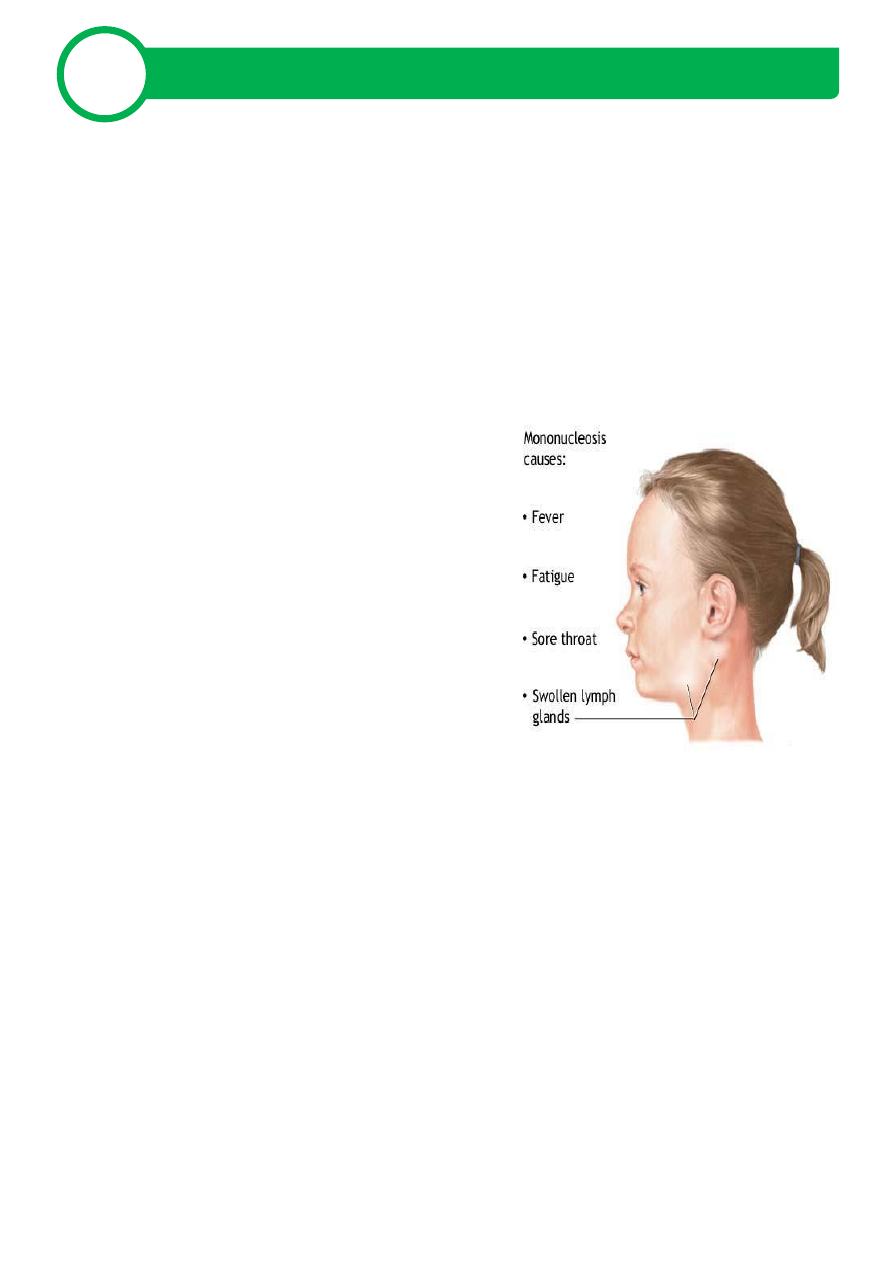
Pediatrics Fifth Stage – G:E Infectious Mononucleosis.
3
Molecular Biology: EBV Subtype
• 2 subtypes
– EBV-1 (type A): Western countries
– EBV-2 (type B): less virulence
• In immunocompromised persons: co-infection both type 1 and type 2
strains
• No one subtype is responsible for specific lymphoproliferative
diseases (geographic differences)
Symptoms.
• Acute infectious mononucleosis
– fatigue and malaise 1-2 wks.
– sore throat, pharyngitis
– retro-orbital headache
– fever
– myalgia
– nausea
– abdominal pain
– generalized lymphadenopathy
– hepatosplenomegaly
• Pharyngitis is the most consistent physical finding.
– 1/3 of patients: exudative pharyngitis.
– 25-60% of patients: petechiae at the junction of the hard
and soft palates.
– Tonsillar enlargement can be massive, and occasionally it
causes airway obstruction
.
• Lymphadenopathy: 90%
– symmetrical enlargement.
– mildly tender to palpation and not fix.
– posterior cervical lymph nodes.
– anterior cervical and submandibular nodes.
– axillary and inguinal nodes.
– Enlarged epitrochlear nodes are very suggestive of infectious
mononucleosis
.
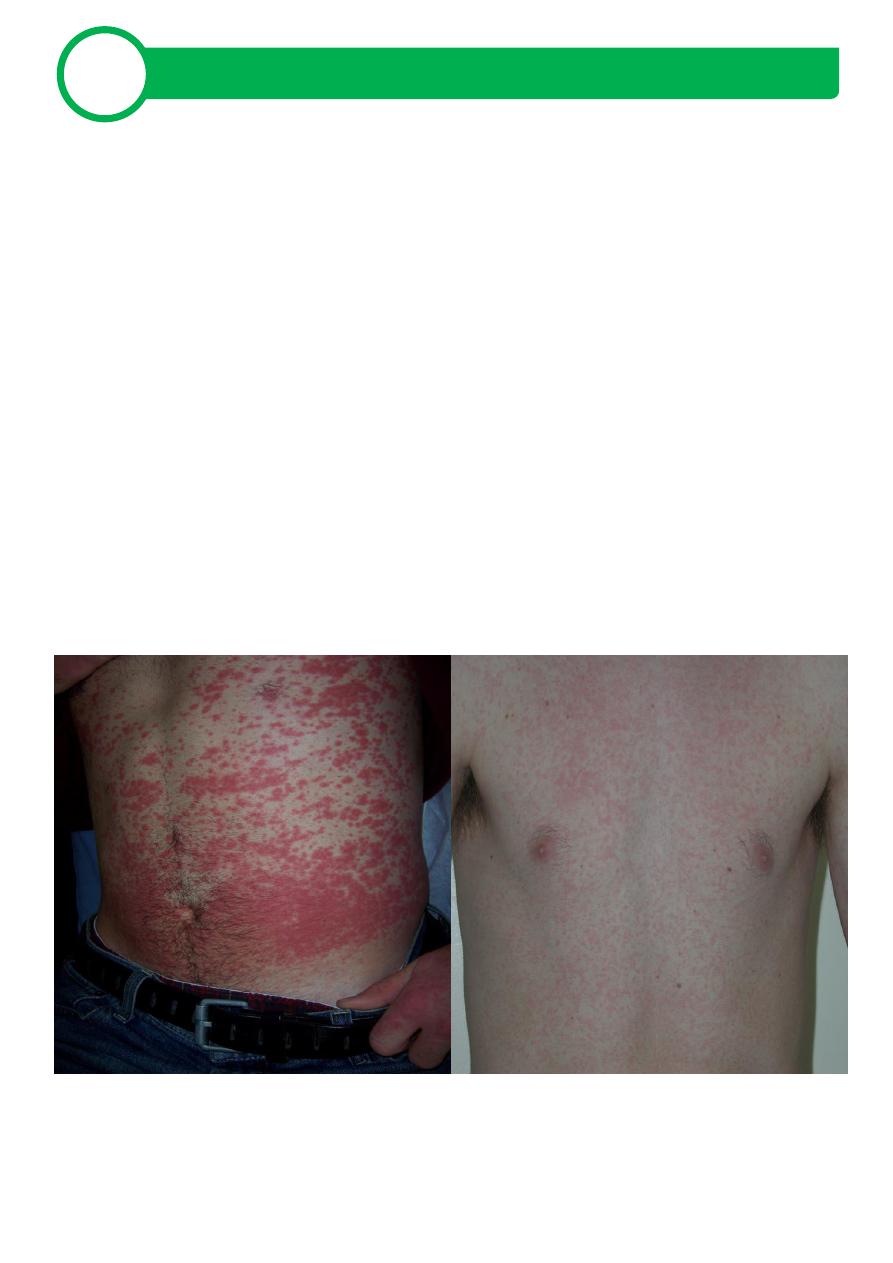
Pediatrics Fifth Stage – G:E Infectious Mononucleosis.
4
• Hepatomegaly: 60%
– jaundice is rare.
– Percussion tenderness over the liver is common.
• Splenomegaly: 50%
– palpable 2-3 cm below the left costal margin and may be tender.
– rapidly over the first week of symptoms, usually decreasing in
size over the next 7-10 days
.
– spleen can rupture from relatively minor trauma or even
spontaneously
.
• Maculopapular rash: 15%
– usually faint, widely scattered, and erythematous
– occurs in 3-15% of patients and is more common in young
children
.
– 80% of patients, treatment with amoxicillin or ampicillin is
associated with rash
– Circulating immunoglobulin G (IgG) and immunoglobulin M (IgM)
antibodies to ampicillin are demonstrable
.
IM with rash after treatment with amoxicillin or ampicillin
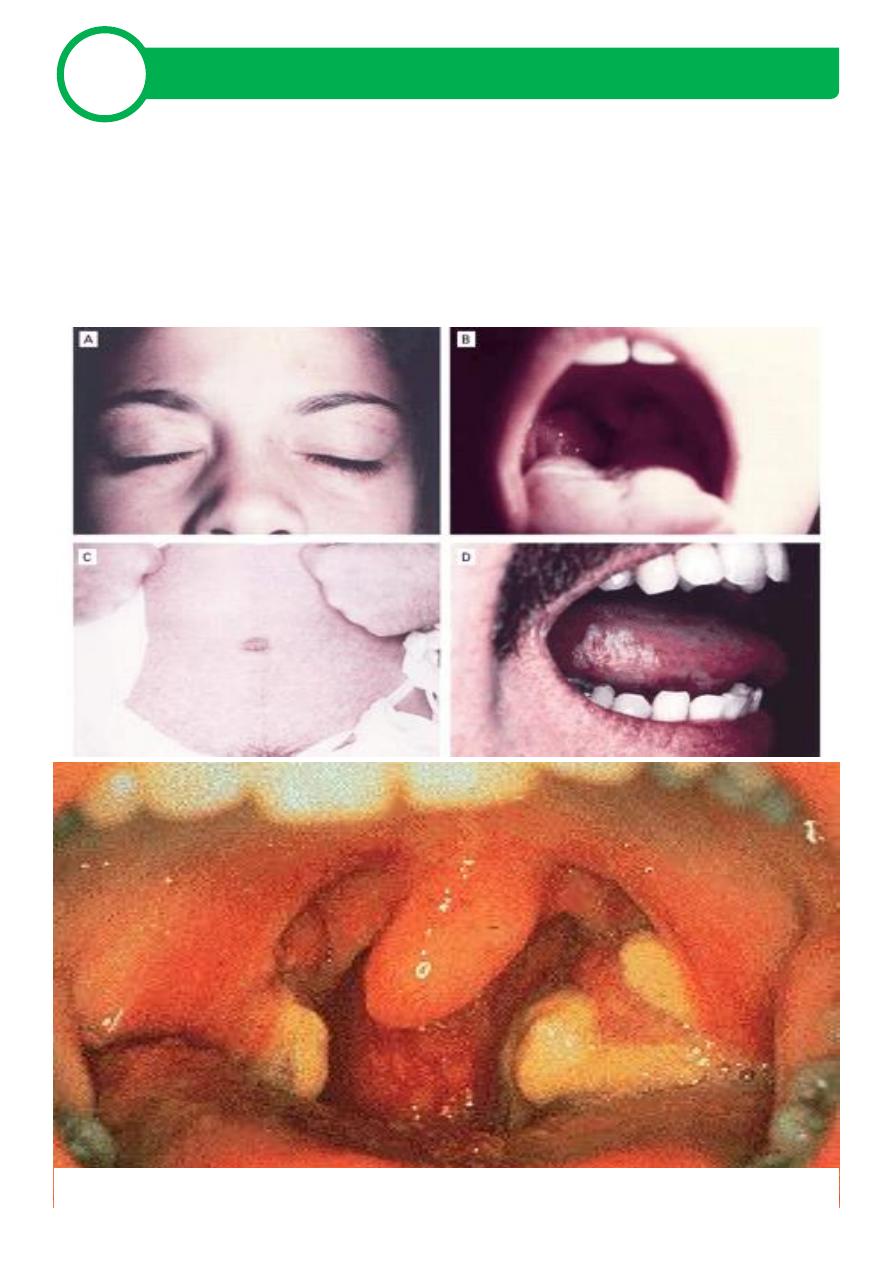
Pediatrics Fifth Stage – G:E Infectious Mononucleosis.
5
• Eyelid edema: 15%
– may be present, especially in the first week
• Children younger than 4 years: more commonly
– splenomegaly or hepatomegaly
– rash
– symptoms of an upper respiratory tract infection
Exudative pharyngotonsillitis
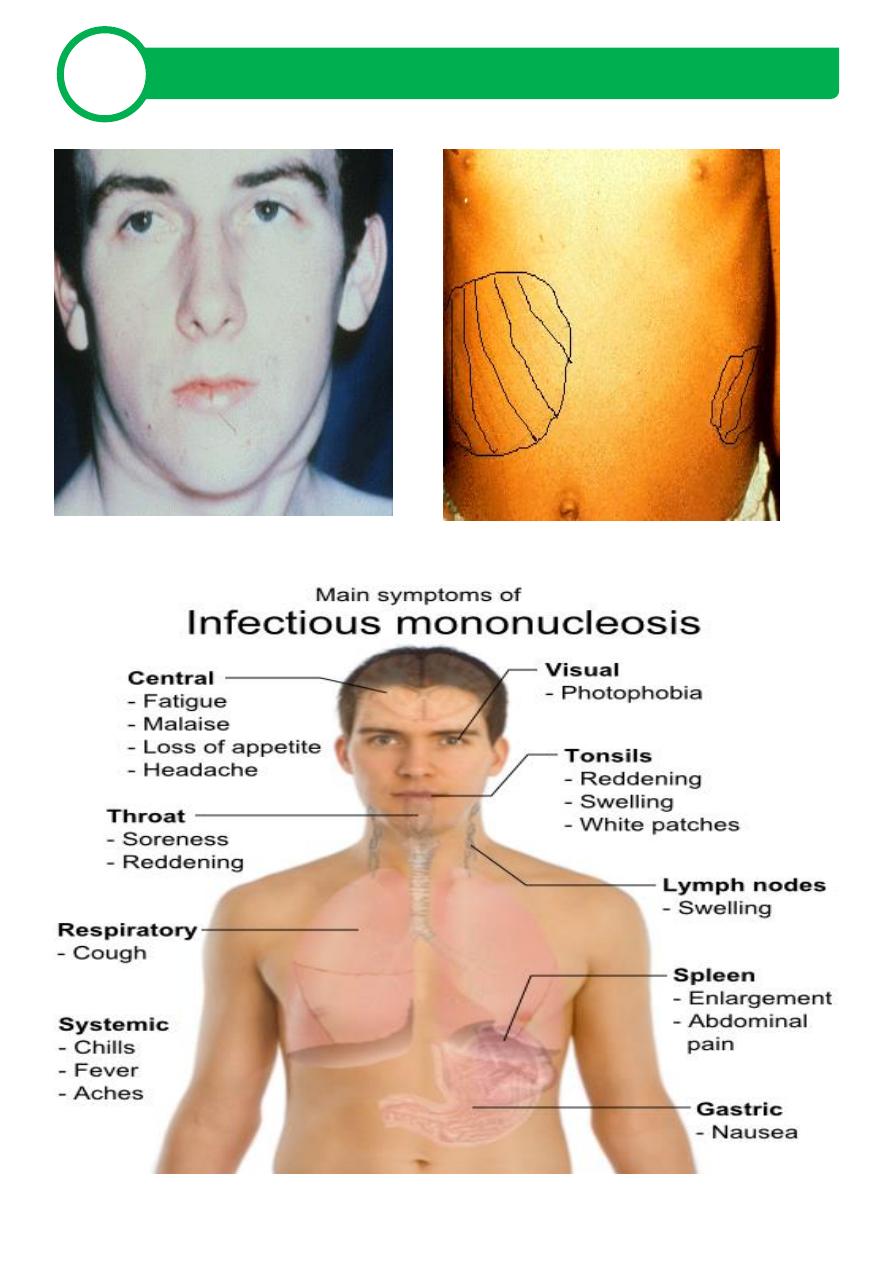
Pediatrics Fifth Stage – G:E Infectious Mononucleosis.
6
Figure 1Cervical lymphadenopathy
Figure 2Hepatosplenomegaly
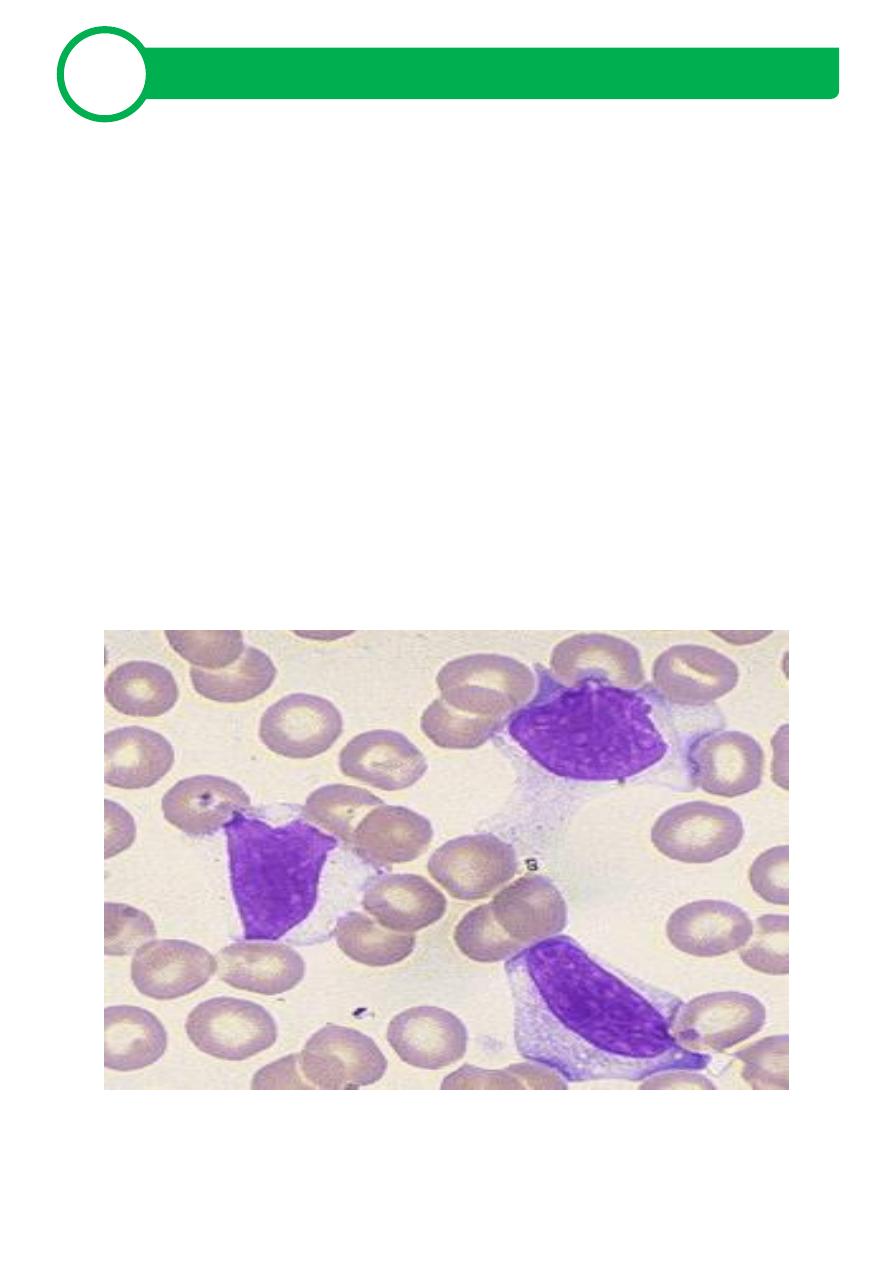
Pediatrics Fifth Stage – G:E Infectious Mononucleosis.
7
Infectious Mononucleosis: Investigation
• The 3 classic criteria for laboratory confirmation
1- lymphocytosis
2- the presence of at least 10% atypical lymphocytes on
peripheral smear
3- a positive serologic test for Epstein
-Barr virus (EBV).
• Complete blood count
– 40-70%, Leukocytosis (WBC 10,000-20,000 cells per cm3)
– By the second week of illness, approximately 10% have a WBC
count > 25,000 per cm
3.
– 80-90% of patients have lymphocytosis, with greater than 50%
lymphocytes
.
Lymphocytosis
is greatest during 2-3 weeks of
illness and lasts for 2-6 weeks
.
– 20-40% of the lymphocytes: atypical lymphocytes > 10%.
– Mild thrombocytopenia
atypical lymphocytes: Downey types

Pediatrics Fifth Stage – G:E Infectious Mononucleosis.
8
• Liver function tests
– 80-100% of patients:
elevated LFT
– Alkaline phosphatase, AST and bilirubin, GGT are elevated.
– 95% of patients:
elevated LDH
– most liver function test results are normal by 3 months.
• EBV serology
– EAs (early antigens): early in the lytic cycle
– VCA (Viral capsid antigen) and membrane antigens: late in the
lytic cycle
– EBNA (Epstein-Barr nuclear antigen): latent infection
– Antibodies to membrane antigens: usually are not measured
• Time course of antibody production
– EA is rising at symptom onset: rise for 3-4 weeks, then quickly
decline to undetectable levels by 3-4 months, although low levels
may be detected intermittently for years
.
– VCA-IgM usually is measurable at symptom onset, peaks at 2-3
weeks, then declines and unmeasurable by 3-4 months
.
– VCA-IgG rises shortly after symptom onset, peaks at 2-3
months, then drops slightly but persists for life
.
– EBNA: convalescence and remain present for life.
IM Treatment
Medical Care
:
• self-limited illness: not require specific therapy.
• Inpatient therapy of medical and surgical complications may be
required
.
•
Acyclovir
(10 mg/kg/dose IV q8h for 7-10 d)
– inhibit viral shedding from the oropharynx
– clinical course is not significantly
•
IVIG
(400 mg/kg/d IV for 2-5 d)
• Short-course corticosteroids
- prednisolone (1 mg/kg/d, max 60 mg/d for 7 d and tapered over
another 7 d)
– Marked tonsillar inflammation with impending airway obstruction
– Massive splenomegaly

Pediatrics Fifth Stage – G:E Infectious Mononucleosis.
9
– Myocarditis
– Hemolytic anemia
– Hemophagocytic syndrome
– Seizure and meningitis
Surgical Care
:
• Splenic rupture.
Activity
:
• depends on severity of the patient's symptoms.
• Extreme fatigue: bed rest for 1-2 weeks.
• Malaise may persist for 2-3 months.
• Patients should not participate in contact sports or heavy lifting for at
least 2-3 weeks
• some authors recommend avoiding activities that may cause splenic
trauma for 2 months
.
IM: Complications
•
Hepatitis
: > 90% of patients
•
Platelet count
: approximately 1 week after symptom onset (100,000-
140,000
/cm3.), then gradually improves over the next 3-4 weeks. Mild
thrombocytopenia occurs in approximately 50% of patients with
infectious mononucleosis
.
• Hemolytic anemia
– 0.5-3%, associated with cold-reactive antibodies, mild and is
most significant during the second and third weeks of symptoms
.
• Upper airway obstruction
– 0.1-1%, due to hypertrophy of tonsils and other lymph nodes of
Waldeyer ring
– treatment with corticosteroids may be beneficial
• Splenic rupture: 0.1-0.2%
– Spontaneous or history of some antecedent trauma.
– occur during the second and third weeks.
– mild-to-severe abdominal pain below the left costal margin,
sometimes with radiation to the left shoulder and supraclavicular
area
.
– Massive bleeding: Shock

Pediatrics Fifth Stage – G:E Infectious Mononucleosis.
10
• Hematologic complications
– Hemophagocytic syndrome.
– Immune thrombocytopenic purpura occurs and may evolve to
aplastic anemia
.
– accelerate hemolytic anemia in congenital spherocytosis or
hereditary elliptocytosis
.
– Disseminated intravascular coagulation associated with hepatic
necrosis has occurred
.
• Neurologic complications: < 1%
– during the first 2 weeks.
– aseptic meningitis, acute viral encephalitis, coma, meningitis,
and meningoencephalopathy
.
– Hypoglossal nerve palsy, Bell palsy, hearing loss, brachial
plexus neuropathy, multiple cranial nerve palsies, Guillain
-Barré
syndrome, autonomic neuropathy, gastrointestinal dysfunction
secondary to selective cholinergic dysautonomia, acute
cerebellar ataxia, transverse myelitis
.
• Cardiac and pulmonary complications
– rare
– chronic interstitial pneumonitis.
– myocarditis and pericarditis.
• Autoimmune complications
–
Autoimmune diseases and Reye syndrome
have been
associated with EBV infection
.
–
Renal disorders
: immune deposit nephritis, renal failure,
paroxysmal nocturnal hemoglobinuria
IM: Prognosis
• Immunocompetent: full recovery in several months.
• The common hematologic and hepatic complications resolve in 2-3
months
.
• Neurologic complications
– Children: resolve quickly
– Adults: neurological deficits
• All individuals develop latent infection

Pediatrics Fifth Stage – G:E Infectious Mononucleosis.
11
Prevention
• Isolation is not required: low transmission.
• Avoid contact with saliva.
• Avoid kissing when in acute phase.
• Maintain clean conditions: avoid sharing toys among children in day
care.
• Vaccine development is proceeding, although the role of a vaccine is
unclear
.
